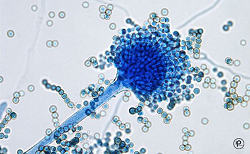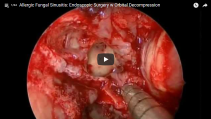To view the original article, click here.
Hello. I am Dr Tom Chiller, deputy chief of the Mycotic Diseases Branch at the Centers for Disease Control and Prevention (CDC). I am pleased to talk to you about antifungal resistance, a topic that needs more attention.
Although antibiotic-resistant bacterial infections are a widely recognized public health threat, much less is known about the burden and consequences of drug-resistant fungal infections. Since the discovery and widespread use of antibacterial medicines in the 1960s and with increasing numbers of high-risk patients, we have seen the emergence and increased rates of serious invasive fungal infections.
Over the past decade, we have made some progress in combating healthcare-associated bacterial infections. Improving care of central venous catheters and a focus on antibiotic stewardship programs have led to decreases in bloodstream infections caused by resistant bacteria, although we still have a ways to go. However, those decreases have resulted in the fungus Candida becoming the most common cause of healthcare-associated bloodstream infections in many hospitals across the United States.[1] The development of a few classes of antifungal agents has given us the ability to treat these invasive infections, but just like bacteria, some fungi have developed resistance and no longer respond to the antifungals that are used to treat them.
Some types of Candida are becoming increasingly resistant to first-line and second-line antifungals—namely, echinocandins and fluconazole. Approximately 7% of all Candida bloodstream isolates tested at CDC are resistant to fluconazole. Most of these isolates are Candida glabrata, 14% of which are resistant.[2,3] The good news is that CDC’s surveillance data indicate that fluconazole resistance has remained fairly constant over the past 20 years.[3,4,5]
In contrast, echinocandin resistance appears to be on the rise, with 3%-5% of C glabrata isolates being resistant to echinocandin.[2] Isolates tested by CDC before 2004 showed no resistance, so this resistance has emerged after the echinocandins became widely used. Today, the prevalence of echinocandin resistance is more than 10% at some hospitals and is continuing to increase.[6,7]
Finally, a growing concern is the presence of multidrug-resistant Candida infections (those that are resistant to both fluconazole and echinocandins), because few treatment options remain, other than amphotericin B. Not surprisingly, there is growing evidence to suggest that patients who have drug-resistant candidemia have worse outcomes than patients who have susceptible infections.[8,9]
Some studies have indicated that antibacterials may also contribute to antifungal resistance; this could occur for a variety of reasons, one of which is that antibacterials reduce bacteria in the gut and create favorable conditions for Candida growth.[10] It’s not yet known whether decreasing the use of all or certain antimicrobial agents can reduce Candida infections, but appropriate use of antibacterials and antifungals is one of the most important factors in fighting drug resistance.
Although most of the resistance that we are concerned about is in Candida species, resistance in other fungi also occurs. I want to highlight the emergence of azole resistance in Aspergillus fumigatus. Since its approval in 2002, the antifungal agent voriconazole has been the primary treatment for invasive aspergillosis. However, more than a decade ago, several countries in Europe began seeing an increasing amount of azole-resistant Aspergillus fumigatus.
Studies in Europe suggest that resistance in Aspergillus may be partially driven by the use of agricultural azoles, which protect crops from fungal diseases.[11,12] Prevalence as high as 30% has been seen in some hospitals in Europe.[13] Patients with these resistant isolates had a much higher mortality—closer to 90%, compared with approximately 40% for patients with susceptible strains.[14] Resistant isolates have been now also identified in the Middle East, Asia, Africa, South America, and most recently in the United States.
The Mycotic Diseases Branch at the CDC is collecting isolates of A fumigatus for US surveillance of resistance. We encourage clinical labs to send samples to CDC. Please refer to the Web resources below for instructions on submitting isolates.
In summary, we encourage hospital executives and infection control staff to:
- Assess antifungal use as part of their antibiotic stewardship programs; and
- Ensure adherence to guidelines for hand hygiene, prevention of catheter-associated infections, and environmental infection control efforts.
We encourage physicians and other hospital staff to:
- Prescribe antifungal medications appropriately;
- Ask their laboratories to routinely determine the species of every Candida sterile body site isolate if it is not reported, and if C glabrata is found, consider ordering antifungal susceptibility testing;
- Document the dose, duration, and indication for every antifungal prescription;
- Be aware of local antifungal resistance patterns; and
- Be active in efforts within your hospital to improve antifungal prescribing.
Medical and Patient education videos
-
Title
Description
-

Kindly provided by Dr Ronan O’Driscoll and with thanks to Dr P Barber, Bronchoscopy Unit, Wythenshawe Hospital, Manchester. Copyright Dr R. O’Driscoll.
-

This talk on CPA was delivered by Professor David Denning to clinicians and laboratory scientists in Ghana on February 1st 2019, World Aspergillosis Day.
-

Although people usually relate fungi with diseases, Dr. Anne Pringle provides an overview of the vastly diverse and complex world of fungi, and provides examples of the beneficial roles that fungi have on Earth. For example, although some fungi have been associated with devastating infections that threaten harvests every year, other fungi are mutualists needed for the healthy development of plants and animals.
In her second lecture, Pringle explains how one can use a “reverse ecology” approach to describe and characterize different organisms and their habitats, by studying their genes. Her laboratory used this approach to study the origins of the Bay Area Amanita phalloides. Although Amanita phalloides was thought to be an invasive species, historical records were mostly descriptive and hard to use as concrete evidence of the species’ biogeography. Using genetic information, the Pringle laboratory was able to definitively prove that early samples identified as Amanita phalloides in the US are distinct from the European species. They also used molecular data to document the symbiotic associations between Amanita phalloides and plants, proving the efficacy of these approaches to study species that are hard to grow in the lab.
In her third lecture, Pringle provides an overview of convergent interactions, defined as the independent emergence of multi-species interactions with similar physiological or ecological functions. For example, multiple plant lineages have independently evolved interactions with fungi in order to exchange resources and form what are known as mycorrhizal symbioses. To further understand how convergent interactions are formed, the Pringle laboratory studied the evolution of plants that have “pitcher”-like structures as well as the mycorrhizal symbiosis in the Amanitagenus.
-

Although people usually relate fungi with diseases, Dr. Anne Pringle provides an overview of the vastly diverse and complex world of fungi, and provides examples of the beneficial roles that fungi have on Earth. For example, although some fungi have been associated with devastating infections that threaten harvests every year, other fungi are mutualists needed for the healthy development of plants and animals.
In her second lecture, Pringle explains how one can use a “reverse ecology” approach to describe and characterize different organisms and their habitats, by studying their genes. Her laboratory used this approach to study the origins of the Bay Area Amanita phalloides. Although Amanita phalloides was thought to be an invasive species, historical records were mostly descriptive and hard to use as concrete evidence of the species’ biogeography. Using genetic information, the Pringle laboratory was able to definitively prove that early samples identified as Amanita phalloides in the US are distinct from the European species. They also used molecular data to document the symbiotic associations between Amanita phalloides and plants, proving the efficacy of these approaches to study species that are hard to grow in the lab.
In her third lecture, Pringle provides an overview of convergent interactions, defined as the independent emergence of multi-species interactions with similar physiological or ecological functions. For example, multiple plant lineages have independently evolved interactions with fungi in order to exchange resources and form what are known as mycorrhizal symbioses. To further understand how convergent interactions are formed, the Pringle laboratory studied the evolution of plants that have “pitcher”-like structures as well as the mycorrhizal symbiosis in the Amanitagenus.
-

Although people usually relate fungi with diseases, Dr. Anne Pringle provides an overview of the vastly diverse and complex world of fungi, and provides examples of the beneficial roles that fungi have on Earth. For example, although some fungi have been associated with devastating infections that threaten harvests every year, other fungi are mutualists needed for the healthy development of plants and animals.
In her second lecture, Pringle explains how one can use a “reverse ecology” approach to describe and characterize different organisms and their habitats, by studying their genes. Her laboratory used this approach to study the origins of the Bay Area Amanita phalloides. Although Amanita phalloides was thought to be an invasive species, historical records were mostly descriptive and hard to use as concrete evidence of the species’ biogeography. Using genetic information, the Pringle laboratory was able to definitively prove that early samples identified as Amanita phalloides in the US are distinct from the European species. They also used molecular data to document the symbiotic associations between Amanita phalloides and plants, proving the efficacy of these approaches to study species that are hard to grow in the lab.
In her third lecture, Pringle provides an overview of convergent interactions, defined as the independent emergence of multi-species interactions with similar physiological or ecological functions. For example, multiple plant lineages have independently evolved interactions with fungi in order to exchange resources and form what are known as mycorrhizal symbioses. To further understand how convergent interactions are formed, the Pringle laboratory studied the evolution of plants that have “pitcher”-like structures as well as the mycorrhizal symbiosis in the Amanitagenus.
-

Medical student, Anastasiya Kret, tells us about her experiences of an eight week summer scholarship funded by the MRC Centre for Medical Mycology where she traveled from Aberdeen to Germany to work in the Department of Pathogenicity Mechanisms at the Hans Knöll institute in Jena. Find out more about the training opportunities within the MRC Centre for Medical Mycology here.
-

Management of allergic and chronic pulmonary aspergillosis. Masterclass
part 3: Disease Progression and approaches to therapy by Prof David Denning. Presented at 5th Advances Against Aspergillosis conference in Istanbul January 2012. -

The Aspergillus Website maintains a collection of Youtube videos on fungal sinusitis. To access the whole collection click on the link at the top of the image above.

